Greatgrandfather William
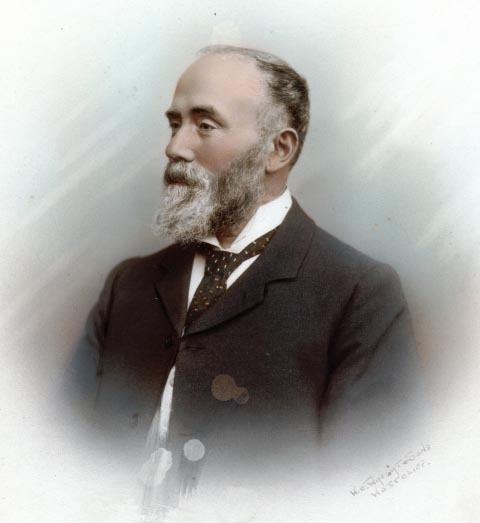
All through my childhood I was aware of Greatgrandfather William's photograph. An ornately framed, hand coloured picture of a rather severe elderly man, bearded and suited. In a matching frame was a lady, my greatgrandmother Amelia, a much more approachable character dressed in soft clothing.

Family lore has it that William's parents owned a pub in Hullbridge which, after their untimely deaths, was 'stolen' by William's wicked uncle. After an adolescent argument with his uncle, William left home and walked to London to seek his fortune. He became a butcher and prospered to the extent that he was able to buy out an employer who had slighted him.
When I decided to investigate the family history, William's story seemed a good starting point. Grandad always said that he had been the youngest of fourteen children, so there should be plenty of family to ask. Unfortunately, Grandad had died in 1983 and we seemed to have lost touch with his family.
Fortunately Dad had recently heard from his cousin Ann Meadows - a descendant of Grandad's older brother Charles. Ann turned out to be a great ally, soon becoming as engrossed as I was in the task. Between the pair of us, we eventually tracked down most, if not all, of William and Amelia's descendants. Like most family tales, the legend of William turned out to have a basis in fact though the details were somewhat different.
William's birth and childhood
William Lewin was born 30th August 1845 at 80 Boston Place in the parish of Christchurch Marylebone London. He was the second child of William Lewin and Mary Ann Wright. Both parents came from a background in the licenced trade. William's older sister Sarah Ann was born in Great Burstead, Essex where Mary Ann's parents ran the King's Head public house. William's father was at some time a brewer in Wormingford, Essex.
A London Street Directory of 1850 lists 80 Boston Place, which runs alongside Marylebone Station, as the residence of Richard Street, beer seller. William's father may have worked for Street in the shop - though, as he had previously been a gentleman's servant, it is possible that the family were just lodging at the beer house.
Sometime between 1845 and 1851 William's father became the landlord of a small riverside inn called The Anchor at Hullbridge, a small settlement on the river Crouch, in the parish of Hockley. This postcard from around 1900 shows the Anchor on the right. At the end of the road is the slipway for the ferry over the River Crouch..
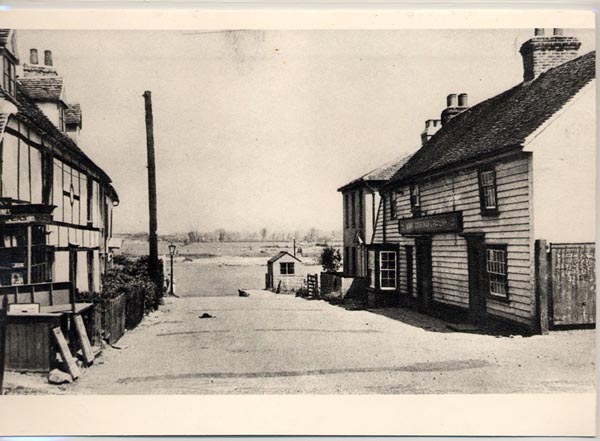
Today Hullbridge still gives a feeling of remoteness, even though it was heavily developed during the twentieth century. It is easy to imagine how isolated it must have seemed in 1850. The area was renowned for smuggling; an activity that may still have been practiced during William's father's tenure of the inn. The Anchor was located at the end of the road from Hockley, just where it reaches the river Crouch. At low tide the river is said to be fordable here and it would certainly have been a good place for a ferry. In the 1851 census one of the two servants living-in at the inn is recorded as a 'ferreman'. There is still an Anchor Inn in Hullbridge but it is a more recent building in a different location.

In April 1857 when William was 11 his father died of 'Disease of the Heart', aged just 43. The Chelmsford Chronicle described the circumstances: "Sudden death.-On Saturday evening last, Mr. Wm. Lewin victualler, at Hull Bridge, was removing a disorderly character from his premises when he was observed suddenly to fall, and, on being taken up, life was found to be extinct, The result of the inquisition has not yet reached us." [Chelmsford Chronicle - Friday 17 Apr 1857.] Two years later his mother died of 'Cardiac Disease', aged 37. Whether from a sense of family duty, or as family legend would have it, through avarice, the Lewin children were taken care of by their mother's younger brother, Thomas Wright, who moved into the Anchor along with his wife Mary Ann and their baby son William.

William and Sarah were still living with their aunt and uncle at the Anchor at the time of the 1861 census when Sarah is recorded as a barmaid. William aged 15 has neither 'scholar' nor an occupation alongside his name. It seems likely that Thomas apprenticed William to his own trade as a butcher as this was his occupation for the rest of his working life. There is a family story that William was thrown out by his uncle after a row and walked to London to seek his fortune. What seems more likely is that William was guardian of Sarah and William's estate until they came of age. The family left the Anchor at about the time of William's 21st birthday in August 1866. Thomas Wright is recorded as Landlord of the Anchor in 1867 but had left by 1871. The Wrights moved to Ramsden Crays and later Wickford where Thomas Wright kept a butchers shop.
1871 - 1914 A Growing Family
We next catch up with William in the 1871 census when, aged 26, he was living at 8 Exeter Place, Knightsbridge, London. His occupation was 'butcher'. The census offers a revealing snapshot of a family crisis as it shows William living with an otherwise unknown 'wife' called Mary while his future wife, Amelia Gentry, was visiting her parents. She was recorded as Amelia Lewin and was accompanied by a three month old son, William Lewin.
Amelia, the daughter of John Gentry, wheelwright, and Charlotte nee Wright, was born in Stanford-le-Hope in December 1849. In January 1871 she gave birth to a son, William, at 8 Exeter Place. It was Amelia who registered the birth and gave her name as Amelia Lewin and stated the father was William Lewin, butcher. She and baby William then went to Essex to stay with her parents. The census shows Amelia's younger sister Charlotte visiting the house of William's uncle, Thomas Wright. Possibly on a family diplomatic mission to get William to 'do the decent thing'.
By November 1871 Amelia and baby William had returned to London where William died aged 10 months. Amelia registered the death, again giving her name as Amelia Lewin and naming William Lewin, 'butcher', as the father; the address is given as 20 Queen Street - just around the corner from Exeter Place. Two months later on January 21st 1872 William and Amelia were married at the church of St Simon, Chelsea, a stone's throw from 20 Queen Street where they were both living. The witnesses were John Gentry and Charlotte Gentry who may have been Amelia's parents or her brother and sister. The marriage banns, as well as being read on 17th 24th and 31st Dec 1871, had also been read on 5th 12th and 19th March, a couple of months after William was born, but no marriage then took place. What had happened to delay the wedding? On both occasions when the banns were read William and Amelia were described as being 'of this parish'.
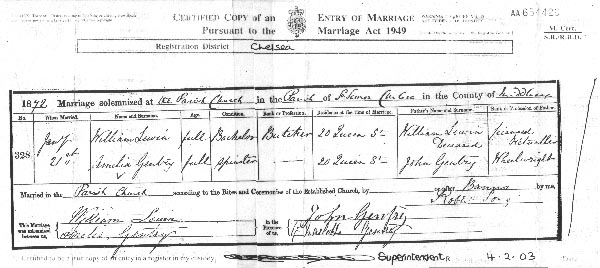
There is also a mystery surrounding the birth of William and Amelia's second child Ellen. She appears on the 1881 census aged 9, so she was born in late 1871 or early 1872, around the time of baby William's death and William and Amelia's marriage. In the 1881 census Ellen's place of birth is given as Stanford-le-Hope but it does not seem to have been registered there. The baptism registers for St Simon Chelsea or Stanford-le-Hope may provide some clues. It is also possible, knowing William and Amelia's attitude towards the provision of civil information at this time, that the birth was not registered.

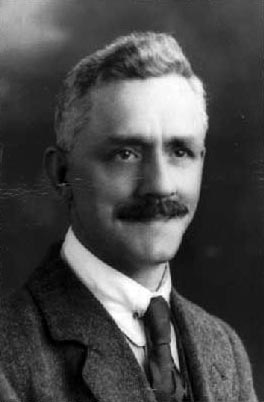
By 1874 when their second son (also named William, above left), was born, William and Amelia had moved to Middle Hill Egham Surrey where he was working as a butcher. The family were still living in Egham when Charles William (above right) was born in 1877, Alice Elizabeth in 1878 and Frederick Henry in 1879. As yet nothing more is known about their time in Egham.
William and his young family are thought to have moved from Egham to Mile End London shortly before April 3rd, the date of the 1881 census in which they were recorded at 86 Turners Road Mile End Old Town. They had not been there long because the Post Office Directory for 1880 shows the butcher's business here as belonging to John Gates, from whom it is presumed William bought it. There is a family story that he developed a chain of shops and bought out a previous employer who had sacked him but no evidence has yet been found of him owning any shop other than the one in Turners Road. Mile End was a rapidly growing area of the East End at this time. Turners Road ran parallel to, and south of, the London and Blackwall railway which at this point runs along an embankment. It would have been an extremely busy line at this time and the steam trains of the day must have generated considerable noise and pollution. There were houses on both sides of Turners Road which ran from Stepney Road, crossing Burdett Road, a major thoroughfare and shopping area, and on eastwards to join Bow Common Lane. From maps of the period it seems likely that 86 was on the opposite side of the road to the railway line and according to the 1881 census 'before Baythorne Street.' This places it on the stretch of Turners Rd between Burdett Road and Bow Common Lane.
There may have been a small group of shops at this point on Turners Road as in the 1881 census there is a fishmonger at 84 and a grocer at 88. By the time of the 1891 census the fishmonger had gone and by 1901 the grocer also. The enumerator for the 1881 census noted 'Railway arches in rear of Turners Road were chiefly occupied as stables, cartloads and storehouses - not one was used as a sleeping place.' It is possible that William rented one of these arches for storage or to keep a horse and cart. Len remembered, as a young lad, taking the horse-drawn cart down to the wharf to collect ice which was brought up to the wharf by barge, but whether this was in William's horse and cart or one belonging to a carrier is not known. A further indication of the type of area the Lewins were living in comes from the 1889 Booth's Map of London Poverty. The occupants of Turners Road are designated 'Category 5; Social Classes F & G i.e. Fairly comfortable good ordinary earnings.'
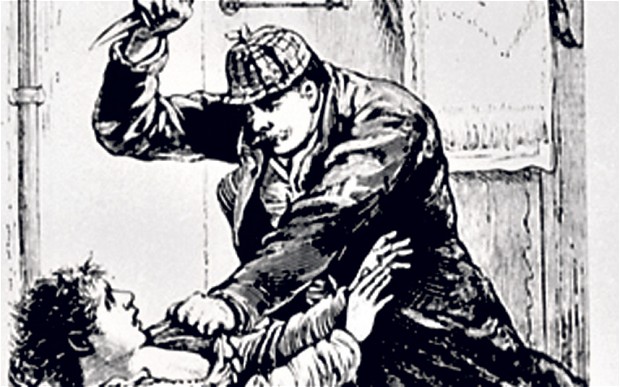
As a butcher living in the East End in 1888, it seems likely that William would have been questioned by police about the Jack-the-Ripper murders. No hint of this has come down in family lore though - very disappointing!
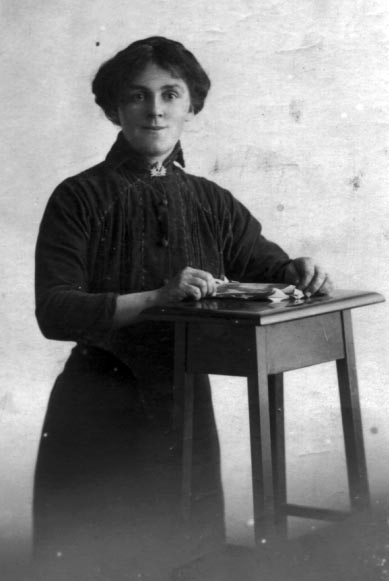

During the following twelve years, from 1882 to 1894, William and Amelia had 9 more children and suffered the deaths of 5 children. Catherine Annie (Kate, above left) was the first of their children to be born in Turners Road, in May 1882. Later that year Ellen died aged 10. Edith Mary (Edie) was born in 1883; Ethel Maud in 1885; Harry in 1886, who died later the same year; Hilda Gertrude in 1887 who died aged 1; Mabel Hilda in 1889 who died later the same year and Herbert Edward (Herbie) in Nov 1890. In 1891 Ethel died aged 5 and in October 1894 Louis Leonard (Len above right) was born.
As well as fathering 13 children with Amelia, William also had a child by their live-in housekeeper Elizabeth Garnham who was with them, aged 18, at the time of the 1891 census. Grace Gertrude Garnham was born at 59 Hatcham Park Road Deptford in August 1893 a year before Len, William's youngest child by Amelia. William appears to have acknowledged his responsibility for Grace and her mother and taken it seriously. According to Len, Grace was brought up as a member of the family. How Amelia reacted to this state of affairs is not known. One suspects she may have had little say in the matter.
Len remembered William as being a very powerful father. He had a strict routine which had to be adhered to. In the morning the maid prepared his dressing gown and slippers, ironed his morning paper and warmed the seat of the W.C. Then there would be a scramble while all the family tried to get done before the great man awoke. When he did, he would disappear into the toilet with his paper for hours on end. No-one must disturb him for no-one was supposed to know he was there. On many occasions that servant may have been Elizabeth Garnham.
We do not know which school/s the Lewin children attended, or how long they were there, but it is probable that they all received a basic education. The likelihood is that Bill, who at some stage acquired the nickname 'Toady', and later Fred, were first apprenticed either to their father or another butcher, while the family were living in Mile End, as both became butchers running their own shops later in life. In 1892, aged 16, Charlie obtained an apprenticeship to train as an electrician at Bow Common Gasworks. What Alice, who was known in the family as 'Duck', did on leaving school is not known. She is living with the family at Capel Road in 1901 but no occupation is given. She had a reputation as a 'bluestocking' and was possibly a campaigner for women's rights. She drank stout and smoked and, as a young woman, is said to have outraged her family by keeping a crate of stout in her room. She worked as Matron at a girls' school at some stage but whether this was before or during the war is not certain. At the time of the 1901 census Kate, aged 18, is described as a dressmaker and Edie, as a draper's assistant. Herbie probably started school in Mile End but later moved to Godwin Road School in Forest Gate. Len may have started school in Mile End but was only about 6 when he went to live in Forest Gate and also attended Godwin Road School.
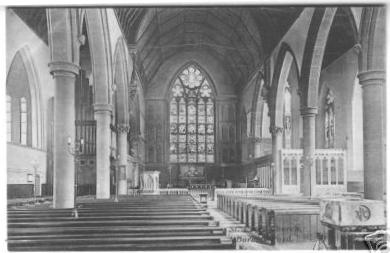
Baptism and Burial entries for most of the Lewin children who were born or died at Turners Road are to be found in the registers for St Paul's Bow Common. This church, at the junction of Burdett Road and St Paul's Road, was not far from their home. Whether the family had any other involvement with the Church is not known. It seems unlikely that Amelia would have had time for any activities other than bearing and looking after her many children, although we do know she had the help of a live-in maid/housekeeper for some of the time. William would probably have been held in some regard as a Tradesman, but as yet there is no evidence that he was involved in any other activities in the community.
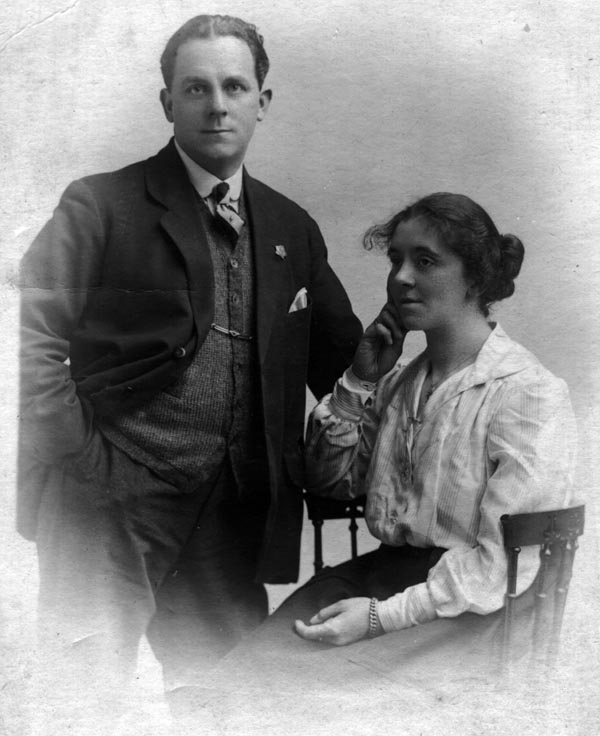
Fred fought in the Boer War which started in 1899, when he would have been 20, and lasted until 1902. According to Robert (a grandson of William) he was wounded by a bullet which passed through his calf and killed his horse. (Fred - seen above with his wife Ethel - was a private in the 11 Battalion Imperial Yeomanry. He was awarded the Queen's South Africa medal with Cape Colony, Orange Free State, Transvaal and South Africa 1901 clasps.) This must have been a worrying time for William and Amelia. A photograph of Bill in uniform suggests that he too may have enlisted as he looks to young for it to be a first world war photo.

In 1900 William rented 16 Capel Road East Ham overlooking Wanstead Flats and he and Amelia moved there with their grown up daughters Alice and Edith and sons Herbert aged 10 and Len aged 6. Kate, who would have been 17 at the time, probably lived there too but at the time of the 1901 census was with her grandmother Charlotte Gentry in Essex. Grace and her mother are thought to have remained in Mile End when William moved to Capel Road. Whether they stayed on at 86 Turners Road or moved to accommodation William acquired for them is not known. Neither Grace nor her mother are recorded anywhere in the 1901 census. One New Year during this period Grace sent a postcard showing the inside of St Paul's Church to Alice at Capel Road and wrote 'Dear Alice I hope you are well and I thought you would like this card wishing you a happy new year From Grace with love'. Unfortunately the stamp has been removed - who was the stamp collector? - so there is no postmark to give an exact date. The move to East Ham seems to have been quite a step up in the world as in 1928 the rent of the house in Forest Gate was twice that of the properties in Turners Road.
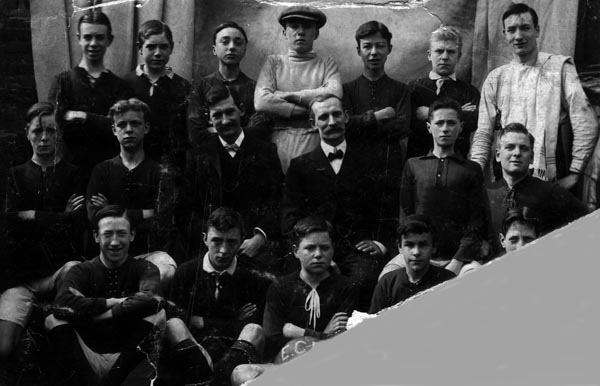
During the period at Forest Gate Herbie and Len attended Godwin Road School and probably also the local Church of England church as Len talked of singing in the choir of St Michael's. Herbie left school at 13 or 14, to work as an office boy with a City firm. Len however was less successful at 'escaping' the butchers' trade. In his teens he was a skilled footballer and was offered a trial by one of the premier football clubs; but his father had other ideas, insisting he become apprenticed as a butcher Len may have served his apprenticeship in Basingstoke, as he told his grandchildren a story of how he lost a cow in the covered market there. His involvement in football is recorded in a photo of him in his local football team that he to sent to his brother Charlie as a birthday card. It bears no stamp and postmark so we can only guess at the date; probably for Charlie's birthday on April 28th 1910 or 1911. Len is probably the lad sitting at the right hand end of the middle row.
It is not clear who ran the butchers shop in Turners Road when William moved out to East Ham. Bill is thought to have been in charge for some of the time but in the 1901 census he is still a journeyman butcher living in Marylebone, so presumably working for another butcher. He is thought to have been in charge at Turners Road at some point but by all accounts lacked the business acumen of his father and didn't make a very good job of it. Charlie was the head of household at 86 Turners Road in the 1901 census and remained there until his marriage to Edith Musk Hazall on April 11th 1904. With him at number 86 is Richard Smith, journeyman butcher, recorded as his nephew but thought more likely to be his cousin, son of William's sister Sarah Ann. It is possible that William was still managing the business with Richard as his apprentice.
Through a great deal more delving the story of William's sister Sarah Ann's was pieced together. She was working as a barmaid at The Anchor Hullbridge in 1861 aged 16. Early in 1866, aged 21, she married James Smith a boat builder in Gravesend Kent. They appear to have had at least three children all born in Gravesend; Sarah Frances born fourth quarter of 1867, Frederick Arthur (Frank) born first quarter of 1869 and Richard born third quarter of 1879. By the time of the 1881 census Sarah Ann and Richard aged 2 were in the Union Workhouse, Trafalgar Road, Gravesend, Milton. The reason for this and what happened to the other children is yet to be discovered. By 1891 Richard had moved from the main workhouse to the Maidstone Union School but there is no trace of his mother, who may have died. It is assumed that Sarah Ann and her brother William had lost touch as it is unlikely he would have knowingly let her go to the workhouse. How her son Richard came to re-establish contact with the Lewins is not known, nor what happened to him when Charlie left 86 Turners Road in 1904. As he was a butcher he may have stayed on with the butcher who took over at number 86.
On 11th April 1904 William and Amelia, now living in Forest Gate, would have attended the first wedding of a child of theirs when Charlie married Edith Musk Hazall at St Paul's Bow Common. They became grandparents for the first time when Edie gave birth to a daughter Edith on 4th February 1905. Baby Edith, called Edie, is thought to have been named after Charlie's sister Edie, of whom he was known to have been very fond, rather than after her mother. She was born at 50 Huddert Sreet, another street that ran off Turners Road, where Charlie and Edie were living in rooms they had rented since their marriage. Why they moved here rather than stay on at the Turners Road premises is not known, but may be another indication that arrangements were changing at the Turners Road premises at this time.
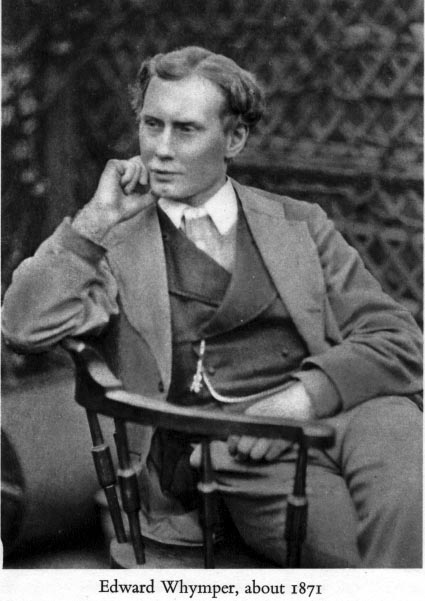
The second of William and Amelia's children to marry was Edie. She married the explorer and artist Edward Whymper, whom she met while staying or working with her great aunt Louisa Wright who ran a guest house at 4 Cliff Town Parade Prittlewell Southend-on-Sea where Edward is thought to have stayed when not away on climbing expeditions. Edie aged 23 and Edward aged 66 married on 25th April 1906 at Emmanuel Church Forest Gate. The ceremony was conducted by Canon J McCormick, rector of St James Piccadilly, who had assisted Edward after the Matterhorn accident. Edward kept a journal from 25 April 1906, the day of his marriage to Edie, to 16 October 2008. It includes an account of his marriage, followed by a tour of the southern counties of England and an Alpine tour and two further Alpine tours in 1907 and 1908. It is thought likely that Edith accompanied him on at least one of these visits to the Alps; but probably not that in 2007 as she sent her niece Edie a card with a studio photo of herself on bearing the postmark Forest Gate March 21st 2007. The message reads 'Dear Edie Hope Dad & Mamma are well. Give them my love From Auntie Edie.'
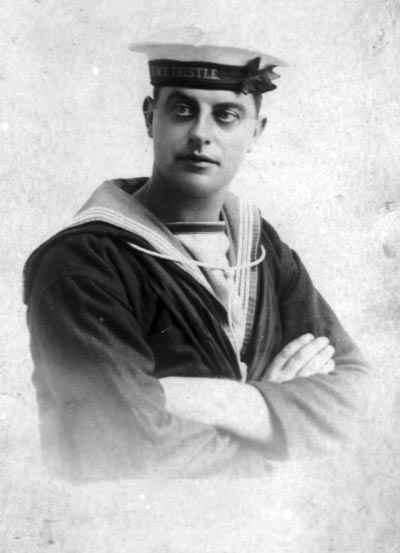
There was a second Lewin wedding in 1906 when Kate married Frederick Camp at St Paul's Bow Common on 23rd September. Kate's address on the marriage certificate is 86 Turners Road, where Bill is thought to have been living at the time. Fred's address is 43 Baythorne Street, just around the corner from 86 Turners Road and the home of Charlie's parents-in-law William and Keziah Hazall. The story goes that William would not have 'allowed' Kate to marry Fred Camp if she had not been pregnant, as he was working as a barrow-boy at the time. William was instrumental in setting Fred up as a Collector for the Liverpool Victoria Friendly Society, no doubt a job he thought more fitting for his son-in-law. Following their marriage Kate and Fred lived at 3 Acland Street Limehouse Stepney and it was here that William and Amelia's second grandchild Frederick George Edward William Camp was born on 12th April 1907. A few months later Charlie, Edie and their 3 year old daughter Edie, left London and moved to Liverpool. Charlie took up a job as an electrician at Linacre Gasworks and rented a newly built house at 27 St Andrews Road Bootle. William and Amelia are known to have kept in touch through letters, and birthday and Christmas parcels, but rarely to have seen these members of their family.
Around this time William and Amelia seem to have left the property in Capel Road and on the 1908 electoral register William re-appears as the occupier at 86 Turners Road with Bill, who has been the occupier for the previous five years, as a lodger. Whether William actually took up residence again and whether Amelia and the children also returned is not known. This may have been the time when William first rented property in Leigh-on-Sea and coincides with the period when Edie and Edward Whymper's marriage ran into difficulty. Edie and Edward had a daughter Ethel Rosa born 14th May 1908 in the Kingston registration district, where Edward's family lived, but by 1910 the marriage was clearly in trouble. Len said that Edward found the presence of a child in the house annoying. He decided to visit the Canadian Rockies and returned home on August 20th but by the end of the month he was in Switzerland. There were whispers in the family that Edie may have been seeing another man. Edie and Edward were judicially separated later in 1910 and on Dec 8th Edward altered his will with the result that when he died on 16 Dec 1911 it made no provision for his wife or child. Edie contested the will and, although provision was made for his child, the will was upheld, as reported in The Times of May 7th 1912. Len Lewin, Edie's brother was appointed one of Ethel Rosa's Guardians. It is not yet clear where Edie and her child were living between 1910 and 1912 but she is likely to have needed considerable emotional, and probably financial, support from William and Amelia during this period.
Several happier family events took place between 1910 and the outbreak of the first world war. On 25th. Sept 1910 William and Amelia had another grandchild when Charlie and Edie's daughter, Ada Amelia, was born in Liverpool. In June 1911 Bill married Eugenie Dawson. They lived initially at 86 Turners Road where Bill is still recorded as a lodger in 1912. By this time William appears to have bought 84 Turners Road where there is a lodger by the name of Knight. Towards the end of 1912 Fred married Ethel May Bedford and Kate and Fred Camp had a second child Kathleen (Kitty) on 14th October. In the third quarter of 1913 Grace Garnham, William's daughter by Elizabeth Garnham, married John Le Grande at St Paul's Bow Common. It seems that while William ensured Grace was brought up as one of the family he never formally acknowledged her as his daughter. In the marriage register the space for the name of her father has a line through it. Later in 1913 Edie married Cecil Logan in Taunton. When and how she met Cecil, whether he was the person it was rumoured she had developed a relationship with in 1910, or why she moved to Taunton are not known.
The War Years - 1914-18
During the war Bill is shown as the occupier of 86 Turners Road and William as the occupier of 84, though as he and Amelia are known to have been living in Leigh-on-Sea it is unlikely he spent much time here. What is more likely is that William and Amelia had moved out of London permanently by 1913. In that year Kelly's Directory records him living at Rochelle, 3 Cliff Road, Leigh-on-Sea and his occupation is 'Gentleman'. For the duration of the war he and Amelia lived in almost identical property nearby at 5 Upland Rd.

The first family event of the war period was to be a sad one when, towards the end of 1914, Edie died in Taunton at the age of 30. Oral history says that she died in childbirth but there is no evidence of a child having been born. Alice is thought to have looked after Edie's daughter Ethel Rosa for a period of time after her mother's death, but she is thought also to have spent time with her father's family. Ethel Rosa was known in the family as 'Chickie'. This is thought to have been because she was looked after by Alice who was known as 'Duck'.
It must have been an anxious time for William and Amelia when Len, who was 18 when war broke out, enlisted and was sent first to France and then to Turkey. He told his grandchildren that on one occasion when he was a mule handler his mule refused to walk along the duck-boards during a landing. The corporal got angry and tried to shift the mule - who promptly kicked him in to the sea. In telling the story he made light of the fact that all this happened as they were under fire.
Sometime between April and July 1915 William had another grandchild when his daughter Grace Le Grand gave birth to a daughter Eunice in Mile End and during the following twelve months he and Amelia had four more grandchildren. In August 1915 news came from Liverpool that Charlie's wife Edie had given birth to twin girls Lena Evelyn and Daisy Ethel on August 19th. Three months later Bill and Eugenie's only child Leonard Horace (Len) was born on November 15th in Mile End and on January 16th 1916, Kate and Fred Camp's third child Mary, was born in Tooting.
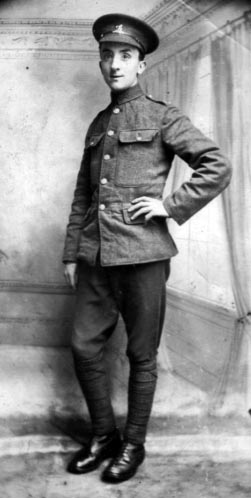
Sometime during 1916 Herbie, who was living with sister Kate and her family at 57 Varney Rd. Tooting, enlisted in the Pay Corp but was not posted overseas. On December 20th 1916 he married Minnie Lucy Bushnell who lived next door to the Camps at 55 Varney Rd. Kate's husband Fred Camp was a witness at the wedding then shortly afterward, on 4th January 1917, enlisted in the Navy. Following their marriage Herbie and Minnie lived with Kate and her children and it was here that their first child Robert Edward (Bob) was born in December 1917. The last family event of the war period was, like the first, to be a sad one. On 23rd May 1918 Kate's husband Fred Camp died as a result of injuries sustained in an accident on board HMS Thistle, at the time off Durban, leaving Kate a widow with 3 young children. Fred was laid to rest in Stellawood Cemetery Durban and the Ladies Section of the Natal Branch of the Navy League arranged for a memorial stone to be erected on the grave. They wrote to Kate to tell her this and arranged for her to receive photographs of the grave and a donation of £30 'a small token of our sympathy with you and your little ones'
The Post War Years
By the end of the war neither William nor Bill are recorded as the occupier of a property in Turners Road. Sometime after their son Len was born in Nov 1915, Bill and Eugenie are thought to have followed William and Amelia to Leigh-on-Sea, where they lived at 30 Adelia Crescent. Bill is thought to have had a butchers shop there and later a whelk stall. It seems likely that by this time William had also purchased 99 Turners Road, on the other side of the street to 84 and 86, and rented out all three properties, which he still owned at the time of his death. In 1918 number 86 was still a butchers shop and the property was occupied by Richard Green and Richard Lewsey. Both 84 and 99 were occupied by members of the Le Grand family, presumably relatives of John Le Grand who Grace Garnham had married in 1913.
The 1920 to1926 directories for Leigh-on-Sea show William to be back at 3 Cliff Road where he and Amelia lived until shortly before his death. In 1920 they had a further granddaughter Margaret Catherine, daughter of Herbie and Minnie who was born at Varney Rd, where they were still living with Kate Camp and her children. January 21st 1922 would have been William and Amelia's Golden Wedding Anniversary. It is not known whether they had a family celebration. By 1923 John and Grace LeGrand are recorded living at 35 Wallwood Rd, near Turners Road, a property to which William held the freehold at the time of his death. There is no mention of Grace's mother Elizabeth but it is thought likely that she lived there too as this is the address given for her, as well as for Grace, in William's will. In February 1925 William and Amelia would have celebrated the marriage of their youngest child Len to Eva Eaby in Westcliffe. William's last family event was the birth in June 1925 of another grandchild Betty Evelyn, daughter of Herbie and Minnie, who by then were living in Carshalton.
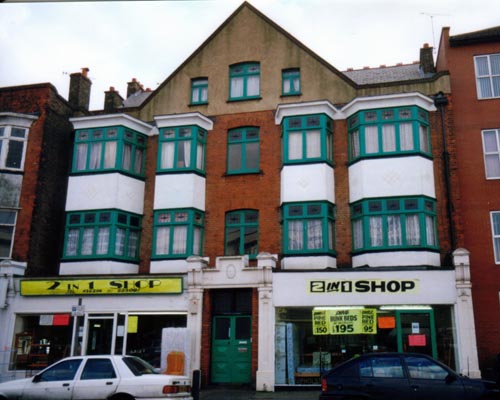
William and Amelia are thought to have been cared for towards the end of their lives by their eldest daughter Alice, who hadn't married. During 1926 they moved from 3 Cliff Road to 646b London Road, a flat in a substantial purpose built apartment block, and it was here that William died of bronchitis and heart failure on December 15th 1926 aged 81. He had fathered 15 children, 8 of whom were alive at the time of his death, and had 11 grandchildren. He had developed a successful business and earned enough for his family to live comfortably. He may not have given Amelia an easy life but they had been together for 54 years. At his request William was buried in the cemetery at Leigh-on-Sea, as was Amelia who died on July 13th 1928 aged 79. She had born 14 children over a period of 23 years, experienced the death of 6 of them during her lifetime and had 12 grandchildren; the youngest, Francis William (Frank) son of Len and Eva, having been born in February 1927, two months after William's death. The inscription on their gravestone reads
In Loving Memory of William Lewin Died 15th December 1926 aged 81 Years also of Amelia Lewin Died 13th July 1928 RIP.
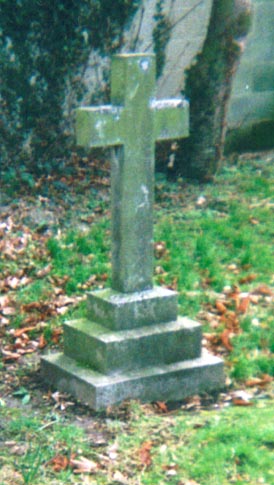
Note: In his will William described himself as a Gentleman. He left an estate with a gross value of £2463-15-7 and a net value of £884-9-1 to Amelia for the duration of her life and thereafter to his children, Elizabeth Garnham and Grace Le Grand, or their heirs, in equal parts.
The beneficiaries after Amelia's death were: William Lewin; Charles William Lewin; Alice Elizabeth Lewin; Frederick Henry Lewin; Catherine Annie Camp; Ethel Rosa Whymper; Herbert Edward Lewin; Louis Leonard Lewin; Elizabeth Harriet Garnham; Grace Gertrude Le Grand.
In his census return in 1911, William declared that his marriage to Amelia had produced 17 live births. We have only traced 14. Did he exaggerate or are there other children still to be found?
This account of William and Amelia's story is based on research undertaken by Greg Lewin and Ann Meadows, two of their great-grandchildren, with contributions from some of their children, grandchildren and other great-grandchildren.